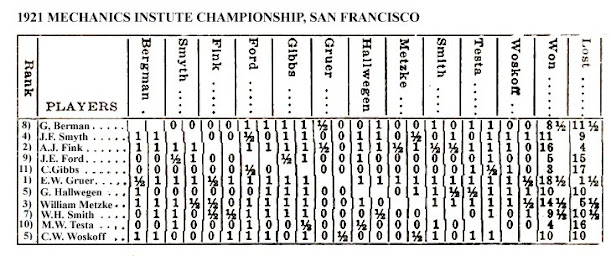The Mechanics’ Institute in San Francisco, California was founded in 1854 and is one of the oldest institutions on the West Coast of the United States.
In 1921, 11 players took part in the annual “major tournament.” The winner was E. W. Gruer who went undefeated with an excellent +17 -0 =3 score.
The two brilliancy prizes were won by C. Woskoff and J. F. Smyth. It’s odd, but Woskoff won the First Brilliancy Prize for his win over J.E. Ford, but Woskoff himself was the victim in Smyth’s Second Bvrilliancy prize.
No information seems to be available on J.E. Ford and all that is known of Charles Woskoff (August 8, 1879 – May 12, 1870, 90 years old) is that he was born in Russia and in his day he was considered one of the giants of California chess.
I am not sure how brilliant the game is, but Woskoff’s attack using a Rook lift is instructive. In a Rook lift a Rook is actively placed in front of its own Pawns to attack the opponent’s King and in this game Woskoff uses it to perfection.
[Event "Mechanics Institute, San Francisco"]
[Site "?"]
[Date "1921.??.??"]
[Round "?"]
[White "Charles Woskoff"]
[Black "J.E. Ford"]
[Result "1-0"]
[ECO "C10"]
[Annotator "Komodo Dragon 3"]
[PlyCount "67"]
[EventDate "1921.??.??"]
{This game won First Brilliancy Prize C10: French Defense} 1. e4 e6 2. d4 d5 3.
Nc3 Nf6 4. Bd3 {Ab unusual reoky which has brought white some success. Usuak
is 4.Bn5 or sometimes 4.e5} dxe4 5. Nxe4 Nbd7 6. Nf3 Be7 7. O-O c6 (7... c5 8.
Nxc5 Nxc5 9. dxc5 Qa5 10. c6 bxc6 {White stands slightly better, but
eventually lost. Kortschnoj,V (2645) -Gurevich,D (2535) Bern 1996}) 8. c3 O-O
9. Re1 Re8 {A better idea was 9...c5 challenging white in the center. As
played black drifts into a passive position.} 10. Bf4 Nf8 11. Ne5 Nd5 12. Bd2 {
[%mdl 2048]} Qc7 13. c4 Nb6 {After this white gets a very menacing position. A
better try was to challenge white with 13...f6} (13... f6 14. cxd5 exd5 15.
Nxc6 bxc6 16. Nc5 {But here, too, white has the superior position.}) 14. Qh5
Ng6 {A better defense was 14...g6, but in either case black is facing serious
difficulties.} 15. Bf4 Qd8 {White now begins a very strong attack using a
common tactic in these type of positions...a Rook lift.} 16. Re3 Nd7 {
Realizing the N had no future on b6, black returns it to the defense.} 17. Rh3
Nf6 {A very instructive position has arisen. It appears that with all the
pices surrounding his K that they make an impregnable defensive wall. That's
not the case; watch how quickly the defense crumbles!} 18. Nxf6+ Bxf6 19. Qxh7+
Kf8 20. Bxg6 Qxd4 21. Bxf7 {Black's K has been stripped of all its defenders.}
Qxf4 (21... Bxe5 {is no help at all; there is a mate in} 22. Qg8+ Ke7 23. Qxe8+
Kd6 24. Bxe5+ Qxe5 25. Qd8+ Bd7 26. Rd1+ Qd5 27. c5+ Kxc5 28. Rxd5+ exd5 29.
Qxd7 Re8 30. Bxe8 Kd4 31. Rc3 Ke5 32. Qe7+ Kf4 33. Rf3+ Kg4 34. h3#) 22. Qg8+
Ke7 {The K has no safe haven and mate is inevitable.} 23. Qxe8+ Kd6 24. Rd1+
Kc7 25. Ng6 {Not to nit pick, but after this white's advantage has shrunk to
12 Ps.} (25. Bxe6 Qxe5 26. Qf7+ Kb6 27. Rb3+ {mates in}) 25... Qxc4 26. Ne7
Bxe7 {This puts white back on track for a forced mate in 11 moves...not that
it ,atters because his position was hopeless no matter what he played.} 27.
Qxe7+ Kb6 {For the next few moves resigning would be a plausible option.} 28.
Rb3+ Ka5 29. Qa3+ Qa4 30. Qc5+ b5 31. Ra3 Qxa3 32. bxa3 Bb7 33. Bxe6 Re8 34.
Qxa7+ {Black resigned} 1-0



No comments:
Post a Comment